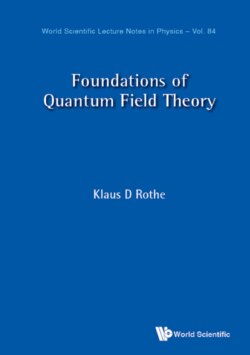Читать книгу Foundations of Quantum Field Theory - Klaus D Rothe - Страница 7
На сайте Литреса книга снята с продажи.
PREFACE
ОглавлениеQuantum Field Theory (QFT) emerged in the 1930’s as a natural extension of Quantum Mechanics to include Special Relativity and particle creation in its second quantized formulation.
Over the years QFT has gone through an extensive evolution with regard to the role of the quantum fields involved, the range of applicability (elementary particles, phase transitions in solid state physics), the treatment of infinities (renormalization) resulting from its local structure (microcausality), the asymptotic behaviour of Green functions (Callan–Symanzik equation, asymptotic freedom), and the analyticity property of transition amplitudes (S-matrix theory).
In particular one has learned why Quantum Electrodynamics (QED) is so successful at low energies, whereas perturbative Quantum Chromodynamics (QCD), the theory of the strong interactions, is successful at high energies (asymptotic freedom, deep inelastic scattering). One has further learned that phenomena such as spontaneous symmetry breaking observed in solid state physics (ferromagnet) also plays a role in the theory of weak interactions in particle physics, where it is referred to as “Higgs mechanism”.
The present lectures essentially represent the content of a two-semester course held by the author at the University of Heidelberg, and thus provides an adequate time-frame for the lecturer and student. As such it was intended to be a compact book providing a bird’s eye view of the very basic foundations of QFT, including the traditional operator, as well as the more modern path integral approach, and should serve as a good basis for post-graduate students, and as orientation for lecturers. Very extensive treatises of the subject can be found in the still excellent book of Bjorken and Drell, as well as in more up-to-date books, such as by C. Itzykson and J.-B. Zuber, E. Peskin and D.V. Schroeder, Lewis H. Ryder and S. Weinberg, which have also served as a basis for these lectures.1 Aside from the author’s point of view in presenting, choosing and arranging the material, most of it can be found in some or other way in the existing literature. We have tried to present the material in reasonable detail, with emphasis on transparency and repeated cross references, at the expense of being sometimes pedantic. We therefore believe that the reader will be able to follow the material without engaging in detailed calculations, which are cumbersome at times. Though we have exemplified various regularization procedures (Pauli–Villars, Dimensional, Taylor-subtraction), we have dominantly used the traditional Pauli–Villars regularization as being the most intuitive one.
We paid much attention in Chapter 2 to the Lorentz group and its representations in Hilbert-space, since they play a fundamental role in Chapters 3 and 5, where some knowledge of Group Theory on the part of the student is assumed. Much of these particular chapters is based on a series of remarkable articles by Steven Weinberg in Physical Review 1964, which underline the fundamental ideas behind the construction of a Quantum Field Theory from the operator point of view.
Many interesting topics could not be covered in these lectures. Thus subjects such as the conformal group and analyticity of scattering amplitudes have only been marginally touched. In particular, Quantum Chromodynamics and the Weak Interactions were not included. They would have exceeded the intended size of this book, and have been left to other more extensive treatises. In turn, we left much room for the Callan–Symanzik equation, which has received considerable attention in the seventies, and will also be revisited in Chapter 18 with regard to the renormalization group. Although the renormalization group actually preceded chronologically the work of Callan and Symanzik, we have preferred to first present the latter, since it connects directly with the chapter on renormalization in Chapter 16.
As for the figures, they were drawn with the aid of the program “METAFONT” developed by Thorsten Ohl and others.2 Although the diagrams are perhaps not as professional as those of publishing companies, the procedure to generate them with “METAFONT” is nevertheless of remarkable simplicity in limited cases. This is the reason for having restricted ourselves to presenting only examples of diagrams directly related to the text. Furthermore, only references related directly to the text were quoted. An extensive list of references can be found in the above cited books.
I would like to thank Dr. Elmar Bittner for being always ready to help me with his expertise to solve computer related problems, and to Thorsten Ohl for helping me with some more complicated diagrams.
________________________
1J.D. Bjorken and S.D. Drell, Relativistic Quantum Fields (McGraw-Hill, 1965); C. Itzikson, and J.-B. Zuber Quantum Field Theory (McGraw-Hill, 1980); E. Peskin and D.V. Schroeder, Frontiers in Physics, 1995; Lewis H. Ryder, Quantum Field Theory (Cambridge University Press, 1985 and 1996); S. Weinberg, The Quantum Theory of Fields (Cambridge University Press, 1996).
2Thorsten Ohl, CERN Computer Newsletter 220 April 1995, 221 October 1995 and December 1996.
